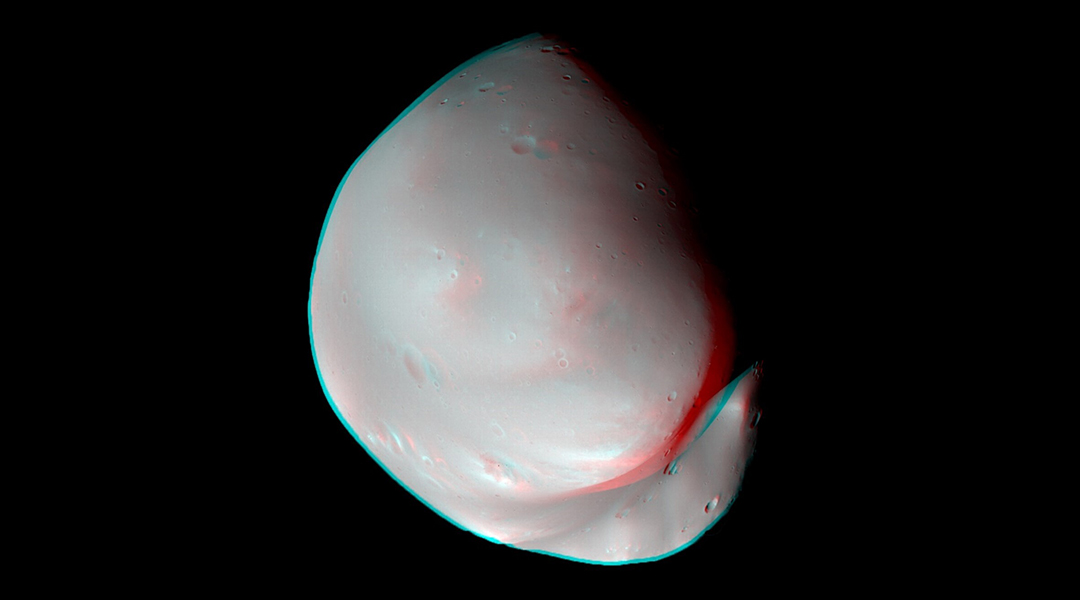The United Arab Emirates (UAE) Mars orbiter, Hope, has captured an incredible close-up image of the Martian moon, Deimos. The spectacular image shows the Martian moon in stunning detail with the Red Planet in the background.
Beyond its aesthetic value, however, the close-up of Deimos is scientifically important as it shows the moon seems to be made of the same material that composes the surface of its parent planet. This may suggest a different origin, implying that the 12.4-kilometer-wide Deimos was created at some point in Mars’ ancient history, when a massive space rock collided with the Red Planet.
“From our initial observations, as I mentioned, the makeup of Deimos is not that of a type-D asteroid, as was previously postulated but appears more consistent with the makeup of Phobos and, indeed, of Mars itself,” said Hope science mission lead Hessa Al Matroushi. “That would support a Martian origin for Deimos, but defining the mechanism responsible for the formation of these moons requires further study. As usual, when you answer a question, you end up with more questions — when were these moons created and what mechanism led to their creation?”
The fist detailed observations
The images of Deimos were captured when Hope, previously known as the Emirates Mars Mission (EMM), performed the first of many Deimos flybys on March 10, 2023. The orbiter’s instruments observed the moon in multiple wavelengths of light, from infrared to extreme ultraviolet, revealing its composition in detail. The results were revealed at the European Geosciences Union meeting in Vienna on 24 April.
“We had hoped for some nice early images following a number of calibration passes, but when we saw the results from the 10 March 100-kilometer flyby, it was really a beautiful moment,” Al Matroushi continued. “It’s an odd feeling, to know something is ‘there’ but to be the first humans ever to actually see it. There’s a sense of childlike wonder to it all and it somehow seems unreal.”
The tiny Martian moon is tidally locked to the Red Planet, meaning that one side of Deimos perpetually faces Mars (just like our own Moon). As a result, Al Matroushi explained that previous observations of Deimos have been made from below the moon, with spacecraft around Mars following lower orbits. Hope, however, has a high and elliptical Mars orbit that Al Matroushi said supports full-disk Deimos observations over each nine-day orbital period.
“We are passing Deimos consistently closer than any other spacecraft and have so many opportunities to make observations together with the advanced nature and high resolution of Hope’s instruments we can trap totally new viewpoints of the moon and fully investigate its origins,” she continued.
This meant that Hope was able to image Deimos from above and was able to capture the moon’s farside for the first time. This achievement is even more impressive when considering that Hope, which launched in July 2020 and arrived at Mars in Febuary 2021, wasn’t initially intended to observe Deimos as its primary mission. The spacecraft’s main goal was to study the atmospheric dynamics and physics around Mars.
“Once we had achieved our primary science goal of fully observing Mars’ atmospheric dynamics over a Martian year, a slight change to that orbit to make close flybys of Deimos was a perfect target for our extended mission,” Al Matroushi said. “And we continue to make observations of Mars’ atmosphere and auroras in line with our original core science goals, so it’s really a win-win.”
Promoting science at home
Al Matroushi explained that Hope has another important mission much closer to home: promoting science in the UAE. “The Emirates Mars Mission was conceived to accelerate the UAE’s space systems engineering, research, innovation, and educational ecosystems, and steer the development of the country’s space capabilities as well as its focus on STEM education,” said Al Matroushi.
“It has been enormously successful in that regard and has been not only transformational for these sectors but has led to a fundamental shift in people’s attitude to risk and the wealth and diversity of their future potential. People in the Emirates think differently now,” she continued. “School students here in the Emirates now dream of going to space, of being a scientist. That’s the real goal.”
Al Matroushi explained that the Hope mission will now make more observations of Deimos from a closer viewpoint than ever before. The spacecraft should therefore deliver higher definition observations across new wavelengths and from a different perspective all of which will contribute to uniquely detailed full coverage of the Martian moon, thus boosting our understanding of the Martian system.
“The Deimos observations are the first of a number expected to be made in our campaign of flybys throughout 2023,” she concluded. “After that, in 2024, we have the option to further extend the mission but, in the meantime, we’re still examining Mars’ atmosphere, cloud systems, dust storms, and auroras and building that picture of the ever-changing dynamics of the planet’s weather systems and the interactions between Mars’ atmosphere and the solar wind.”
Feature image credit: Emirates Mars Mission

















